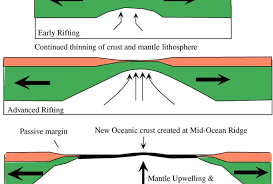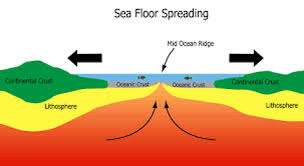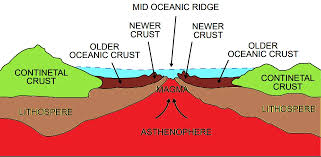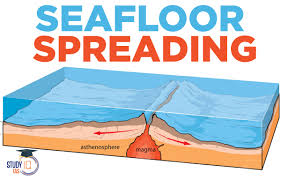Seafloor Spreading and Controversial Geological History 2025
Seafloor Spreading Seafloor Spreading1. Introduction to Seafloor Spreading
Seafloor Spreading is a fundamental process in geology that explains how new oceanic crust is formed. It occurs along mid-ocean ridges, where molten material from Earth’s mantle rises and solidifies into new crust.
This concept has reshaped our understanding of plate tectonics and the dynamic nature of Earth’s lithosphere. Without Seafloor Spreading, the theory of continental drift would lack strong geological evidence.
By studying this process, scientists can better grasp how oceans expand, continents shift, and geological features evolve across millions of years.
2. The Discovery of Seafloor Spreading

The discovery of Seafloor Spreading in the 1960s revolutionized geology. Before then, Alfred Wegener’s theory of continental drift was widely debated but lacked a mechanism.
When magnetic stripes were found on either side of mid-ocean ridges, they confirmed symmetrical patterns that matched Earth’s magnetic reversals. This was the breakthrough evidence for Seafloor Spreading.
These findings validated plate tectonics and permanently changed how scientists understood Earth’s structure.
3. Harry Hess and the Theory
Harry Hess, a U.S. Navy officer and geologist, is often credited with proposing the concept of Seafloor Spreading. His work in the early 1960s laid the groundwork for the plate tectonic revolution.
He suggested that new crust forms at ridges and older crust is pushed away, eventually sinking into trenches. This explained both ocean basin expansion and subduction.
His bold hypothesis provided the missing link that made plate tectonics a comprehensive theory.
4. Mid-Ocean Ridges as Birthplaces
Mid-ocean ridges are the most visible locations where Seafloor Spreading occurs. These underwater mountain ranges extend for tens of thousands of kilometers across the globe.
At these ridges, magma continuously rises and cools to form new oceanic crust. Over time, this adds width to ocean basins.
The ridges act like conveyor belts, pushing crust outward and shaping the global seafloor landscape.
5. Magnetic Stripes on the Ocean Floor

One of the strongest proofs for Seafloor Spreading is the presence of magnetic stripes on the ocean floor. These stripes are caused by Earth’s magnetic reversals recorded in cooling lava.
They form symmetrical patterns on either side of the mid-ocean ridge, confirming that new crust is created and pushed outward.
This discovery was critical in proving that the ocean floor is dynamic, not static.
6. Seafloor Spreading and Plate Tectonics
Seafloor Spreading is central to the theory of plate tectonics. Without it, the movement of continents and ocean basins would remain a mystery.
The process demonstrates how Earth recycles its crust, balancing creation at ridges with destruction at subduction zones.
By linking Seafloor Spreading with tectonics, scientists created a unified explanation for earthquakes, volcanoes, and mountain formation.
7. Evidence from Ocean Drilling
Ocean drilling programs have provided core samples that support Seafloor Spreading. These cores reveal that rocks near ridges are younger, while those farther away are older.
This age progression perfectly matches predictions of spreading processes.
Such drilling evidence strengthens the scientific consensus that oceanic crust is continuously renewed.
8. Heat Flow Along Ridges
Heat flow measurements also provide evidence for Seafloor Spreading. Ridges show higher heat levels compared to older oceanic crust.
This heat indicates that magma is actively rising and cooling, forming new crust.
By studying heat anomalies, scientists can map the intensity and activity of spreading centers.
9. The Role of Subduction Zones
Seafloor Spreading cannot be understood without subduction zones. As new crust forms at ridges, old crust sinks back into the mantle at trenches.
This recycling process keeps Earth’s surface area balanced. Without subduction, the planet would continuously expand.
Together, spreading and subduction form the essential cycle of plate tectonics.
10. Seafloor Spreading and Earthquakes
The movement of crust caused by Seafloor Spreading generates earthquakes, especially near ridges and transform faults.
As plates slide and adjust, seismic activity provides direct evidence of the crust’s dynamic motion.
These earthquakes also help scientists map the boundaries and behaviors of tectonic plates.
11. Hydrothermal Vents and New Life
Hydrothermal vents are fascinating byproducts of Seafloor Spreading. They form when seawater seeps into cracks, heats up by magma, and re-emerges rich in minerals.
These vents support unique ecosystems, with organisms that thrive without sunlight.
Thus, Seafloor Spreading contributes not only to geology but also to the discovery of extraordinary biological systems.
12. Ocean Basin Expansion
Over millions of years, Seafloor Spreading leads to the expansion of ocean basins. This explains why some oceans grow larger while others shrink.
For example, the Atlantic Ocean is widening due to active spreading along the Mid-Atlantic Ridge.
This continuous expansion reshapes global geography and influences sea levels.
13. Continental Drift Explained
Alfred Wegener’s idea of continental drift lacked a mechanism until Seafloor Spreading was discovered.
Now, scientists understand that continents move because they are carried along by shifting plates formed at ridges.
Seafloor Spreading provided the missing piece of evidence that transformed a controversial hypothesis into accepted science.
14. The Wilson Cycle
The Wilson Cycle describes the opening and closing of ocean basins over geologic time. Seafloor Spreading is the key driver of this process.
As ridges create new crust, oceans expand; later, subduction closes them.
This cycle explains the long-term evolution of Earth’s surface and the constant reshaping of continents.
15. Seafloor Spreading and Mountain Building
When spreading crust collides with continents, mountains can form. The pressure and uplift caused by plate convergence create dramatic landscapes.
For example, the Andes Mountains are a result of oceanic crust subducting beneath South America.
Thus, Seafloor Spreading indirectly drives some of the world’s greatest geological features.
16. Seafloor Spreading and Ocean Currents
Seafloor Spreading influences the topography of the ocean floor, which in turn affects ocean currents. The ridges created by spreading act as underwater mountain chains that redirect water circulation.
These altered flows contribute to the distribution of heat and nutrients around the planet. This dynamic has significant implications for global climate patterns.
By studying Seafloor Spreading, scientists better understand the relationship between geological forces and oceanographic processes.
17. Paleomagnetism and Seafloor Spreading
Paleomagnetic studies provide direct evidence for Seafloor Spreading. When magma solidifies at ridges, minerals align with Earth’s magnetic field.
Over time, magnetic reversals create symmetrical patterns on both sides of the ridge. These records serve as a timeline of Earth’s magnetic history.
This phenomenon remains one of the most convincing scientific proofs supporting Seafloor Spreading.
18. Sediment Thickness Across Oceans
Sediment distribution across the ocean floor confirms Seafloor Spreading. Near ridges, sediments are thin because crust is young.
Farther from ridges, sediments are thicker, reflecting older crust that has accumulated more deposits.
This gradient demonstrates the continuous creation and outward movement of the seafloor.
19. Seafloor Spreading and Global Climate
The process of Seafloor Spreading influences global climate through carbon cycling and volcanic emissions.
As new crust forms, volcanic activity releases gases like carbon dioxide, impacting atmospheric composition.
Over geologic time, these emissions shape long-term climate trends, linking geology with environmental change.
20. Transform Faults and Spreading Ridges
Seafloor Spreading is often accompanied by transform faults, where plates slide past each other. These fractures offset mid-ocean ridges.
The friction along transform boundaries generates frequent earthquakes.
Such features demonstrate the complex interactions occurring during the spreading process.
21. Hotspots and Seafloor Formation

Hotspots also play a role in Seafloor Spreading by producing volcanic islands. As plates move over fixed mantle plumes, chains of islands like Hawaii form.
These volcanic traces mark the motion of oceanic crust away from spreading centers.
The connection between hotspots and ridges adds depth to our understanding of seafloor dynamics.
22. The Mid-Atlantic Ridge
The Mid-Atlantic Ridge is the best-known site of Seafloor Spreading. Stretching thousands of kilometers, it divides the Atlantic Ocean into two halves.
New crust forms here continuously, pushing Europe and Africa away from the Americas.
This ridge provides a textbook example of spreading in action.
23. The East Pacific Rise
Another major spreading center is the East Pacific Rise. Unlike the Mid-Atlantic Ridge, it spreads more rapidly.
This fast spreading results in smoother topography and less pronounced ridges.
It demonstrates how spreading rates vary around the globe, producing different seafloor characteristics.
24. Indian Ocean Spreading Centers
The Indian Ocean contains several spreading centers, including the Carlsberg Ridge.
These ridges highlight how spreading operates differently in constrained ocean basins.
Studying them reveals unique tectonic interactions influenced by surrounding continental plates.
25. Seafloor Spreading and Island Chains
Island chains often form as a result of Seafloor Spreading combined with volcanic activity.
When magma rises through cracks in the crust, islands emerge above sea level.
Chains such as the Azores and Galápagos provide direct evidence of seafloor formation processes.
26. The Age of Oceanic Crust
Oceanic crust is generally younger than continental crust, thanks to Seafloor Spreading.
No oceanic crust older than 200 million years exists because it is recycled back into the mantle.
This age difference illustrates Earth’s constant renewal of its ocean basins.
27. Continental Margins and Seafloor Spreading
Seafloor Spreading shapes passive continental margins, where crust transitions smoothly from land to deep ocean.
These margins record the breakup of continents and the birth of new ocean basins.
They are essential for reconstructing Earth’s tectonic past.
28. Rift Valleys at Ridges
Mid-ocean ridges often feature central rift valleys formed by crustal stretching.
These valleys mark the precise zones where plates are pulling apart.
Their structure provides visual confirmation of spreading processes.
29. Seafloor Spreading and Volcanic Arcs
While spreading occurs at ridges, subduction zones create volcanic arcs on continental margins.
The two processes are linked through Earth’s crustal recycling system.
Together, they explain the distribution of volcanoes across the planet.
30. The Connection with Earthquakes
Seafloor Spreading zones are seismically active, producing shallow earthquakes.
These quakes map the motion of plates and provide clues to spreading rates.
By monitoring seismicity, geologists confirm the constant movement of Earth’s crust.
31. Oceanic Trenches and Subduction
The destruction of oceanic crust balances Seafloor Spreading through trenches.
These deep depressions mark zones where crust descends into the mantle.
Trenches emphasize the cyclical nature of plate tectonics.
32. Seafloor Spreading Rates
Spreading rates vary globally, from slow (1–2 cm/year) to fast (over 10 cm/year).
These differences affect ridge morphology, crustal thickness, and volcanic activity.
Measuring rates helps reconstruct past ocean configurations.
33. Geological Evidence from Iceland
Iceland sits atop the Mid-Atlantic Ridge, making it a rare location where Seafloor Spreading occurs on land.
Here, geologists can directly observe rift valleys, volcanic eruptions, and fissures.
Iceland provides a natural laboratory for studying spreading processes.
34. Paleogeography and Seafloor Spreading
By tracing past spreading events, scientists reconstruct paleogeography.
These reconstructions show how continents once fit together and drifted apart.
Seafloor Spreading thus unlocks Earth’s deep-time geography.
35. Seafloor Spreading and Supercontinents
The formation and breakup of supercontinents like Pangaea are tied to Seafloor Spreading.
As ridges form, they push landmasses apart, creating new ocean basins.
This cycle repeats across Earth’s history, driving continental rearrangements.
36. The Role of Mantle Convection
Mantle convection is the engine behind Seafloor Spreading.
Hot material rises beneath ridges, while cooler material sinks at subduction zones.
This convection current drives plate motions globally.
37. Seafloor Spreading and Ocean Chemistry
Spreading alters ocean chemistry through hydrothermal activity.
Minerals released from vents enrich seawater with metals and nutrients.
These chemical exchanges shape marine ecosystems and sediment records.
38. Fossil Distribution and Seafloor Spreading
Seafloor Spreading explains why identical fossils are found on continents now separated by oceans.
Once connected, these landmasses drifted apart as oceans expanded.
This distribution provides paleontological evidence of spreading.
39. Seafloor Spreading in Modern Research
Modern research uses sonar mapping, satellites, and robotics to study Seafloor Spreading.
These tools provide high-resolution images of ridges and vents.
Advancements in technology continually refine our understanding of spreading dynamics.
40. Seafloor Spreading and Natural Resources
Seafloor Spreading creates resources such as polymetallic nodules and hydrothermal deposits.
These minerals are critical for modern industries, including electronics.
However, extraction raises environmental concerns that must be managed carefully.
41. Petroleum Potential and Seafloor Spreading
Spreading zones influence sedimentary basins where hydrocarbons accumulate.
Understanding their geology aids in locating petroleum reserves.
Thus, Seafloor-Spreading has both academic and economic significance.
42. Ocean Drilling Programs
Projects like the Deep Sea Drilling Project and Integrated Ocean Drilling Program confirm spreading models.
Core samples reveal crustal ages, sediment patterns, and magnetic signatures.
These programs remain central to studying Earth’s dynamic crust.
43. Computer Models of Spreading
Scientists use computer simulations to replicate Seafloor-Spreading.
These models test hypotheses about mantle flow, crustal formation, and spreading rates.
Such virtual experiments complement physical observations.
44. The Role of Gravity in Spreading
Gravity helps drive plate motion by pulling older, denser crust into trenches.
This process, known as slab pull, works alongside ridge push to sustain spreading.
Together, they form the mechanical forces behind tectonics.
45. Evidence from Bathymetry
Bathymetric maps reveal symmetrical ridge patterns consistent with Seafloor-Spreading.
These underwater topographies show valleys, ridges, and fracture zones.
Such data visually confirm the movement of oceanic crust.
46. Global Distribution of Ridges
Seafloor-Spreading ridges cover over 65,000 kilometers of Earth’s surface.
They form the longest mountain chain on the planet.
This global distribution highlights the scale of spreading processes.
47. Seafloor-Spreading and Volcanic Islands
Volcanic islands often rise along spreading centers.
As magma builds up, peaks emerge above the ocean surface.
These islands provide living proof of seafloor formation.
48. Life Cycles of Ocean Basins
Ocean basins evolve through stages: rifting, spreading, expansion, and closure.
Seafloor-Spreading drives the middle stages of this cycle.
This process ensures that Earth’s surface is never static.
49. The Importance of GPS in Spreading Studies
GPS technology measures plate movements in real time.
These measurements confirm predictions made by Seafloor-Spreading theory.
The precision of GPS strengthens modern tectonic studies.
50. Educational Importance of Seafloor-Spreading
Seafloor-Spreading is a key concept in geology education worldwide.
It introduces students to Earth’s dynamic systems and scientific reasoning.
By learning this process, future scientists gain insight into global change.
51. Geological Surveys and Seafloor-Spreading
Geological surveys play a crucial role in documenting Seafloor-Spreading. Using sonar, magnetometers, and deep-sea drilling, they map the structure of ocean ridges.
These surveys provide comprehensive data for governments, researchers, and industries that depend on accurate geological knowledge.
By systematically studying spreading centers, surveys help expand our understanding of Earth’s geological evolution.
52. Seafloor-Spreading and Earth’s Magnetic Reversals
Magnetic reversals are preserved in oceanic crust through Seafloor-Spreading. When the Earth’s magnetic field flips, newly formed lava records the change.
These symmetrical patterns of polarity form a natural timeline, stretching back millions of years.
They serve as one of the strongest and most elegant confirmations of Seafloor-Spreading.
53. Remote Sensing and Seafloor-Spreading
Remote sensing technologies such as satellites and autonomous underwater vehicles provide high-resolution imagery of spreading centers.
These innovations make it possible to study ridges in places too deep or dangerous for direct human exploration.
By integrating remote data with field research, scientists gain a fuller picture of Seafloor-Spreading dynamics.
54. Seafloor-Spreading and Natural Hazards
Seafloor-Spreading zones are closely linked to hazards such as earthquakes, volcanic eruptions, and tsunamis.
By analyzing spreading centers, scientists can better forecast areas of potential risk to human populations.
This shows that Seafloor-Spreading is not only an academic subject but also a vital field for disaster preparedness.
55. Seafloor-Spreading and Biodiversity
Unique ecosystems thrive along spreading ridges, particularly near hydrothermal vents.
These habitats support organisms that survive without sunlight, relying on chemosynthesis instead of photosynthesis.
Thus, Seafloor-Spreading contributes to the discovery of new species and helps us understand the adaptability of life.
56. Modern Climate Change and Spreading
Seafloor-Spreading indirectly affects climate by influencing carbon release and ocean circulation.
The interaction of volcanic gases with the atmosphere contributes to long-term carbon cycling.
Understanding these connections helps place modern climate change in a broader geological context.
57. Seafloor-Spreading in Academic Research
Universities and institutions worldwide study Seafloor-Spreading to unravel Earth’s geological history.
Through field expeditions, computer models, and laboratory experiments, new insights emerge every year.
This research ensures that the study of spreading remains at the forefront of Earth sciences.
58. The Economic Importance of Seafloor-Spreading
Spreading centers are rich in resources, including minerals like copper, gold, and rare earth elements.
These deposits are increasingly targeted for extraction to support modern industries.
However, balancing economic gain with environmental protection remains a major challenge.
59. Future Directions in Seafloor-Spreading Studies
Future research into Seafloor-Spreading will rely on advanced robotics, AI, and deeper drilling technologies.
These tools will allow scientists to reach previously inaccessible depths of the ocean.
Such progress will refine our knowledge of how Earth’s crust evolves in real time.
60. Conclusion: The Legacy of Seafloor-Spreading
Seafloor-Spreading has transformed our understanding of Earth, linking continental drift, plate tectonics, and ocean basin formation.
It remains a cornerstone concept that unifies geology, oceanography, and climate science.
Ultimately, Seafloor-Spreading shows that our planet is alive, dynamic, and constantly reshaping itself.

